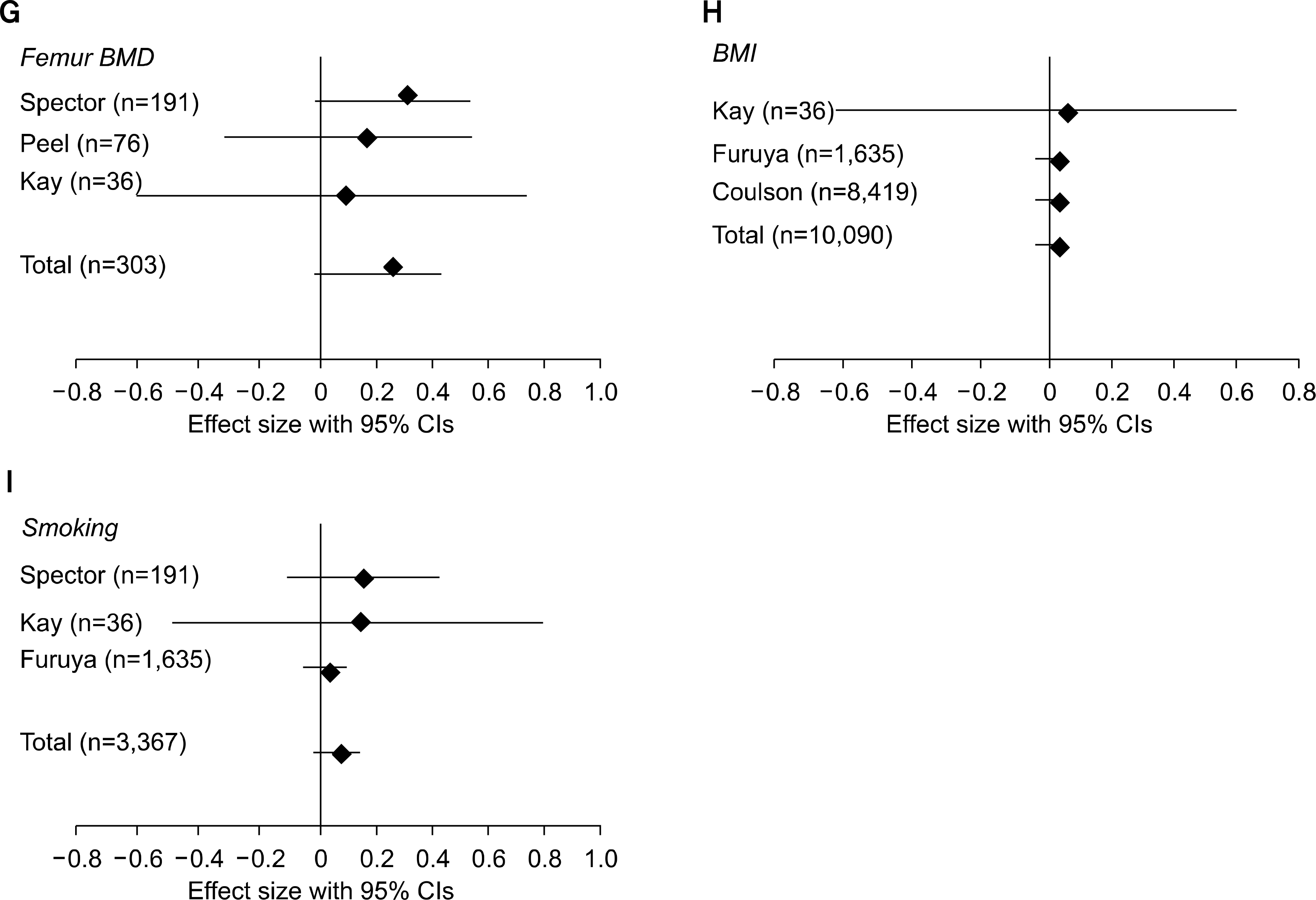1). Spector TD., Hall GM., McCloskey EV., Kanis JA. Risk of vertebral fracture in women with rheumatoid arthritis. BMJ. 1993. 306:558.

2). Kim JY., Lee YW., Ham OK. Factors related to fall in elderly patients with osteoprosis. J Korean Acad Adult Nurs. 2009. 21:257–67.
3). Oh HY., Im YM. Functional status and health care utilization among elders with hip fracture surgery from fall. J Korean Acad Adult Nurs. 2003. 15:432–40.
4). Kay LJ., Holland TM., Platt PN. Stress fractures in rheumatoid arthritis: a cross series and case-control study. Ann Rheum Dis. 2004. 63:1690–2.
5). van Staa TP., Geusens P., Bijlsman JW., Leufkens HG., Cooper C. Clinical assessment of the long-term risk of fracture in patients with rheumatoid arthritis. Arthritis Rheum. 2006. 54:3104–12.

6). Furuya T., Kotake S., Inoue E., Nanke Y., Yago T., Kobashigawa T, et al. Risk factors asociated with incident clinical vertebral and nonvertebral fractures in Japanese women with rheumatoid arthritis: a prospective 54-month obsevational study. J Rheumatol. 2007. 34:303–10.
7). Arai K., Hanyn T., Sugitani H., Murai T., Fujisawa J., Nakazono K, et al. Risk factors for vertebral fracture in menopausal or post menopausal Japanese women with rheumatoid arthritis: a cross-sectional and longitudinal study, J Bone Miner Metab. 2006. 24:118–24.
8). de Nijs RNJ., Jacobs JWG., Bijlsma JWJ., Lems WF., Laan RFJM., Houben HHM, et al. On behalf of the Osteoporosis Working Group of the Dutch Society of Rheumatology Prevalence of vertebral deformities and symptomatic vertebral fractures in corticosteroid treated patients with rheumatoid arthritis. Rheumatology. 2001. 40:1375–83.
9). PeArez-Edo L., Diez-PeArez A., MarinToso L., ValleAs A., Serrano S., Carbonell J. Bone metabolism and histomorphometric changes in rheumatoid arthritis. Scand J Rheumatol. 2002. 31:285–90.
10). Adachi JD., Ioannidis G., Pickard L., Berger C., Prior JC., Joseph L, et al. The association between osteoporotic fractures and health-related quality of life as measured by the Health Utilities Index in the Canadian Multicentre Osteoporosis Study (CaMos). Osteoporos Int. 2003. 14:895–904.

11). Lee HY., Bak WS. The risk factors of osteoporosis in Korean postmenopausal women. J Korean Acad Adult Nurs. 2009. 21:303–13.
12). Irvine DM., Vincent L., Graydon JE., Bubela N. Fatigue in women with breast cancer receiving radiation therapy. Cancer Nurs. 1998. 21:127–35.

13). Song HH. Meta-Analysis for Researches in Medical, Nursing, and Social Science. Seoul, Chung-Moon Gak. 1998.
14). Kim NC., Song HH., Kim JO. Effects of nursing interventions applied to surgery patients: a meta-analysis. J Korean Acad Adult Nurs. 1998. 10:523–34.
15). Fujiwara S., Nakamura T., Orimo H., Hosoi T., Gorai I., Oden A, et al. Development and application of a Japanese model of WHO fracture risk assessment tool (FRAXTM). Osteoporos Int. 2008. 19:429–35.
16). Gronowicz G., McCarthy MB. Glucocorticoids inhibit the attachment of osteoblasts to bone extracellular matrix proteins and disease bT-1 integrin levels. Endocrinology. 1995. 136:598–608.
17). Verstraeten A., Dequeker J. Vertebral and peripheral bone mineral content and fracture incidence in postmenopausal patients with rheumatoid arthritis: effect of low dose corticosteroids. Ann Rheum Dis. 1986. 45:852–7.

18). Laan RF., van Riel PL., van Erning LJ., LEmmens JA., Rujs SH., van de Putte LB. Vertebral osteoporosis in rheumatoid arthritis patients: effect of low dose prednisone therapy. Br J Rheumatol. 1992. 31:91–6.

19). Butler RC., Davie MW., Worsfold M., Sharp CA. Bone mineral content in patients with rheumatoid arthritis: Relationship to low-dose steroid therapy. Br J Rheumatol. 1991. 30:86–90.

20). Sambrook PN., Cohen ML., Eisman JA., Pocock NA., Eberl S., Champion GD, et al. Effects of low dose corticosteroids on bone mass in rheumatoid arthritis: a longitudinal study. Ann Rheum Dis. 1989. 48:535–8.

21). Leboff MS., Wade JP., Mackowiak S., Fuleihan ., Zangari M., Liang MH. Low dose prednisonlon does not affect calcium homeostasis or bone dinsity in postmenopausal women with rheumatoid arthriti. J Rheumatol. 1991. 18:330–44.
22). Michel BA., Bloch DA., Wolfe F., Fries JF. Fracture in rheumatoid arthritis: an evaluation of associated risk factors. J Rheumatol. 1993. 20:1666–9.
23). Paganini-Hill A., Ross RK., Gerkins VR., Henderson BE., Arthur M., Mack TM. Menopausal estrogen therapy and hip fracture. Ann Int Med. 1981. 95:28–31.
24). Michel BA., Bloch DA., Fries JF. Predictors of fractures in early rheumatiod arthritis. J Rheumatol. 1991. 18:804–8.
25). Arend WP., Dayer JM. Cytokines and cytokine inhibitors or antagonists in rheumatoid arthritis. Arthritis Rheum. 1990. 33:305–15.

26). Dequecker J., Geusens P. Osteoporosis and Arthritis. Ann Rheum Dis. 1990. 49:276–80.
27). Peel NF., Moore DJ., Barrington NA., Bax DE., Eastell R. Risk of vertebral fracture and relationship to bone mineral density in steroid treated rheumatoid arthritis. Ann Rheum Dis. 1995. 54:801–6.

28). Nampei A., Hashimoto J., Koyanagi J., Ono T., Hashimoto H., Tsumaki N, et al. Characteristics of fracture and related factors in patients with rheumaotid arthritis. Mod Rheumatol. 2008. 18:170–6.
29). Coulson K., Reed G., Gilliam BE., Kremer JM., Pepmueller PH. Factors influencing fracture risk, T score, and management of osteoporosis inpatients with rheumatoid arthritis in the consortium of rheumatology researchers of north america (CORRONA) registry. J Clin Rheumatol. 2009. 15:155–60.





 PDF
PDF ePub
ePub Citation
Citation Print
Print


 XML Download
XML Download